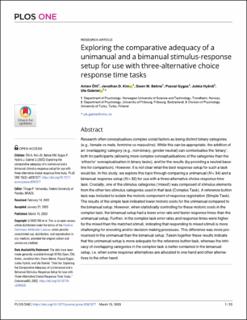| dc.contributor.author | Öttl, Anton | |
| dc.contributor.author | Kim, Jonathan Daniel | |
| dc.contributor.author | Behne, Dawn Marie | |
| dc.contributor.author | Gygax, Pascal M. | |
| dc.contributor.author | Hyönä, Jukka | |
| dc.contributor.author | Gabriel, Ute Barbara | |
| dc.date.accessioned | 2023-09-08T08:46:10Z | |
| dc.date.available | 2023-09-08T08:46:10Z | |
| dc.date.created | 2023-03-16T12:15:29Z | |
| dc.date.issued | 2023 | |
| dc.identifier.issn | 1932-6203 | |
| dc.identifier.uri | https://hdl.handle.net/11250/3088164 | |
| dc.description.abstract | Research often conceptualises complex social factors as being distinct binary categories (e.g., female vs male, feminine vs masculine). While this can be appropriate, the addition of an ‘overlapping’ category (e.g., non-binary, gender neutral) can contextualise the ‘binary’, both for participants (allowing more complex conceptualisations of the categories than the ‘either/or’ conceptualisation in binary tasks), and for the results (by providing a neutral baseline for comparison). However, it is not clear what the best response setup for such a task would be. In this study, we explore this topic through comparing a unimanual (N = 34) and a bimanual response setup (N = 32) for use with a three-alternative choice response time task. Crucially, one of the stimulus categories (‘mixed’) was composed of stimulus elements from the other two stimulus categories used in that task (Complex Task). A reference button task was included to isolate the motoric component of response registration (Simple Task). The results of the simple task indicated lower motoric costs for the unimanual compared to the bimanual setup. However, when statistically controlling for these motoric costs in the complex task, the bimanual setup had a lower error rate and faster response times than the unimanual setup. Further, in the complex task error rates and response times were higher for the mixed than the matched stimuli, indicating that responding to mixed stimuli is more challenging for encoding and/or decision making processes. This difference was more pronounced in the unimanual than the bimanual setup. Taken together these results indicate that the unimanual setup is more adequate for the reference button task, whereas the intricacy of overlapping categories in the complex task is better contained in the bimanual setup, i.e. when some response alternatives are allocated to one hand and other alternatives to the other hand. | en_US |
| dc.language.iso | eng | en_US |
| dc.publisher | PLOS | en_US |
| dc.relation.uri | https://journals.plos.org/plosone/article?id=10.1371/journal.pone.0281377 | |
| dc.rights | Navngivelse 4.0 Internasjonal | * |
| dc.rights.uri | http://creativecommons.org/licenses/by/4.0/deed.no | * |
| dc.title | Exploring the comparative adequacy of a unimanual and a bimanual stimulus-response setup for use with three-alternative choice response time tasks | en_US |
| dc.title.alternative | Exploring the comparative adequacy of a unimanual and a bimanual stimulus-response setup for use with three-alternative choice response time tasks | en_US |
| dc.type | Peer reviewed | en_US |
| dc.type | Journal article | en_US |
| dc.description.version | publishedVersion | en_US |
| dc.source.volume | 18 | en_US |
| dc.source.journal | PLOS ONE | en_US |
| dc.source.issue | 3 | en_US |
| dc.identifier.doi | 10.1371/journal.pone.0281377 | |
| dc.identifier.cristin | 2134414 | |
| dc.relation.project | Norges forskningsråd: 240881 | en_US |
| cristin.ispublished | true | |
| cristin.fulltext | original | |
| cristin.qualitycode | 1 | |

